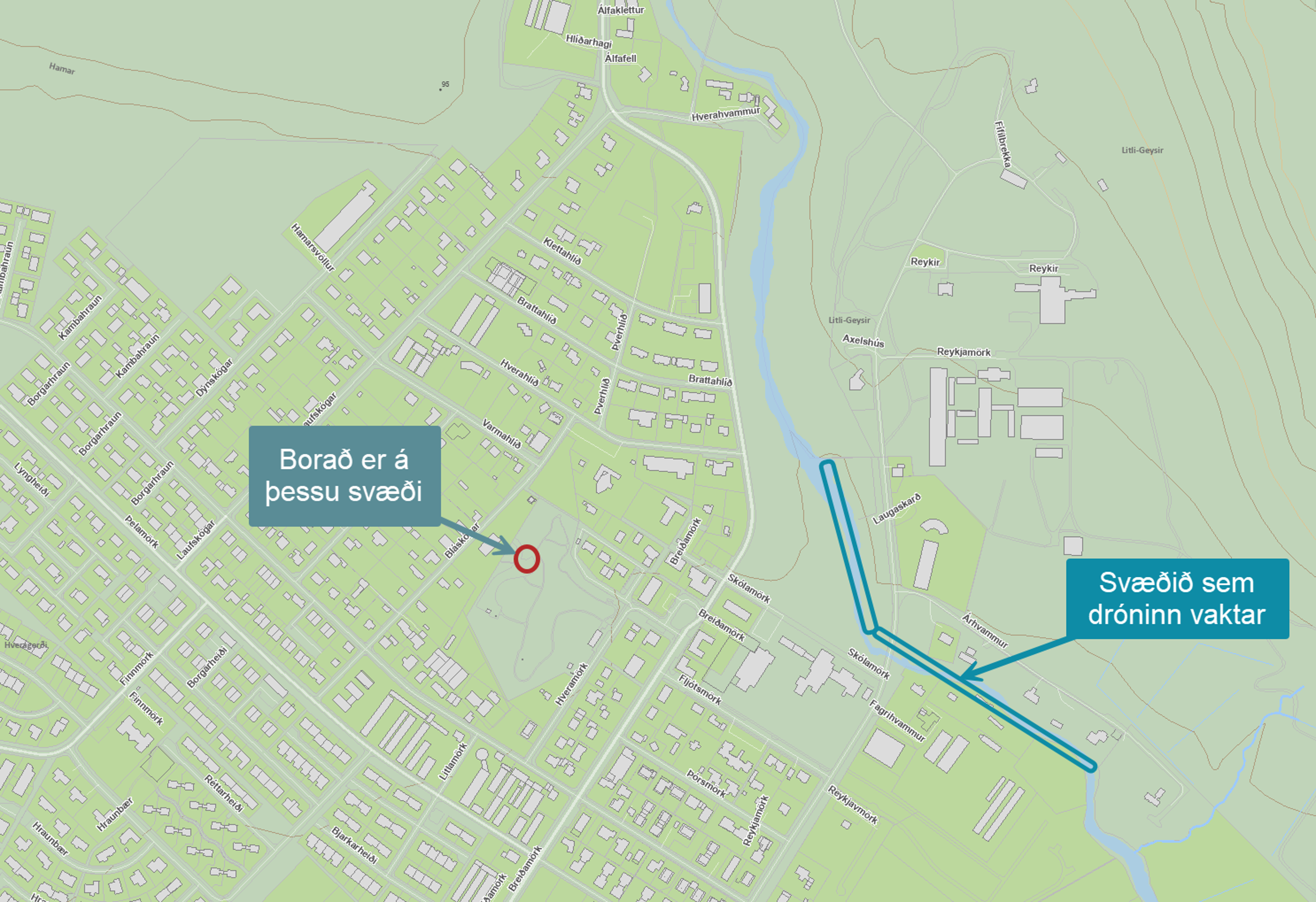Eftirlit með Varmá
- .
Information in English below.

Borun á nýrri holu fyrir hitaveituna í Hveragerði hefst í kringum 10. nóvember. Holan verður staðsett við varmastöð Veitna við Bláskóga. Við borunina verður notað vatn sem sótt verður í Varmá og skilað þangað aftur. Lögð verður tímabundin vatnsveita að borstað og vatninu skilað aftur í stokk sem alla jafna tekur við yfirborðsvatni og veitir því í Varmá við Grunnskólann. Meðan á borun stendur munu Veitur hafa virkt eftirlit með ánni. Eftirlitið með ánni verður bæði á jörðu niðri við árbakkana og úr lofti. Hitastig verður mælt fyrir ofan og neðan útrásina úr stokknum. Þá verður auk þess flogið með dróna yfir ána. Dróninn sér svæðið næst ánni og árbakkanum, en hvorki garða og hús né gesti í sundlauginni.
Við borun er vatn notað til að bera borsvarf, þ.e. bergmulning, sem myndast þegar borkrónan mylur bergið, til yfirborðs. Þegar vatnið kemur upp úr holunni er það gruggugt og verður það leitt í setkör þar sem mest af fastefninu sest til áður en vatnið er leitt í stokkinn og þaðan aftur út í á. Langstærstur hluti þess fastefnis sem berst upp til yfirborðs með skolvatninu á að verða eftir í sekörunum en ekki er hægt að útiloka að einhver hluti af allra fínasta efninu verði eftir í vatninu. Ef til þess kemur gætu komið litabreytingar á ánni við útfallið. Það er skaðlaust en við fylgjumst samt sem áður vel með til að ekkert óvænt komi upp á.
Þeim mun dýpri sem holan verður þeim mun erfiðara er að koma svarfinu (bergmulningi) upp úr holunni og það gerist líklega þegar holan er á 115-275 metra dýpi. Þá er notuð umhverfisvæn sápa, skaðlaus, og froðan sem myndast bindur svarfið betur og kemur því upp úr holunni. Þannig er komið í veg fyrir að svarf berist í æðar holunnar og stífli þær og hafi þannig neikvæð áhrif á vinnslugetu hennar.
Froðan og svarfið (bergmulningurinn) verða fönguð við á borstað, en það er þó mögulegt að froða og fínt svarf berist að einhverjum mæli út í Varmá og hafi þar tímabundin áhrif á ásýnd hennar. Fylgst verður vel með ánni á meðan borun stendur og fyrst eftir að henni lýkur.
Veitur bora nýja holu fyrir hitaveituna í Hveragerði til að tryggja heitt vatn fyrir vaxandi samfélag. Nánari má lesa um borunina og núverandi holu í frétt á vef okkar.
-----------------------------
Drilling of a New Borehole for the District Heating System in Hveragerði
Monitoring of Varmá River
Drilling of a new borehole for the district heating system in Hveragerði will begin around November 10th. The borehole will be located near Veitur’s geothermal station by Bláskógar. During drilling, water will be drawn from the Varmá River and returned there afterwards. A temporary water supply line will be laid to the drilling site, and the water will be returned through a channel that normally carries surface water and discharges it into Varmá near the elementary school.
During the drilling period, Veitur will maintain active monitoring of the river. The monitoring will take place both on the ground along the riverbanks and from the air. Water temperature will be measured above and below the channel outlet. In addition, drone flights will be conducted over the river. The drone will only capture the area near the river and its banks—it will not view gardens, houses, or guests at the swimming pool.
Water is used during drilling to carry the drill cuttings—i.e., rock fragments produced as the drill bit grinds the rock—to the surface. When the water comes up from the borehole, it is cloudy and will be directed into settling tanks where most of the solid material will settle before the water is discharged into the channel and then back into the river. The vast majority of the solids carried to the surface with the flushing water are expected to remain in the settling tanks, though it is not possible to rule out that a small portion of the finest material may remain in the water. If that happens, some color changes might be visible in the river near the discharge point. This is harmless, but we will nonetheless monitor the situation closely to ensure that nothing unexpected occurs.
As the borehole becomes deeper, it becomes more difficult to bring the cuttings (rock fragments) up from the hole. This will likely occur when the borehole reaches depths between 115 and 275 meters. At that stage, an environmentally friendly and harmless soap will be used. The foam that forms helps bind the cuttings and carry them to the surface. This prevents the borehole channels from clogging, which could otherwise negatively affect its production capacity.
The foam and cuttings (rock fragments) will be captured at the drilling site itself, though it is possible that some foam and fine material may reach the Varmá River and temporarily affect its appearance. The river will be closely monitored throughout the drilling process and immediately after it has finished.
Veitur are drilling a new borhole to ensure hot water for a growing community in Hveragerði. More about the drilling and how the district heating in Hveragerði operates.